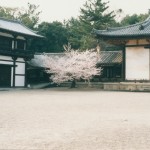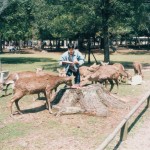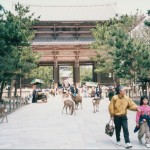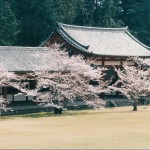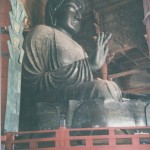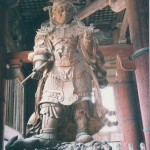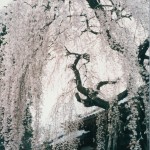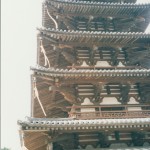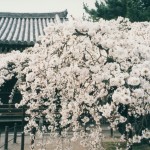Nara Travel Guide
As a traveler in Japan, if there’s one region you cannot afford to miss, it’s Nara prefecture. Home to the highest number of UNESCO world heritage sites in Japan, Nara boasts of ancient Buddhist temples, Shinto shrines, heritage pilgrimage routes, historical monuments, major national parks, hot springs and more.
Main Attractions in Nara
Many of Nara’s most important temples and shrines are inside the Nara-Koen Park – a 4km by 2km stretch of green located in central Nara. Nara Park is known for its shika deer, more than 1200 of which roam freely here and are very friendly with tourists. The deer was traditionally thought of as gods’ envoy and have been given special protection as a designated “Natural Monument” by the Japanese government.
By far Nara’s greatest attraction is the Buddhist temple complex of Todaiji, situated inside the Nara Park. It’s known for the Daibutsu, the world’s biggest bronze Buddha statue. Founded by Emperor Shomu in the 8th century as the head of 68 provincial temples scattered throughout Japan, Todaiji houses the “Daibutsuden”, or the Great Buddha Hall, which is the largest wooden building of the world and is also one of eight historical monuments of Nara designated as World Heritage sites.
Home to Japan’s second tallest pagoda, the Buddhist temple of Kofukuji located in central Nara is another UNESCO World Heritage site wildly popular with tourists. Contemporary to the ancient capital of Nara, Kofukuji was established as the family temple of the most powerful family clan of the Nara period – the Fujiwara. In its heyday, the Kofukuji housed more than 150 temples, only a couple of which remain today – the 50-meters-high five-story pagoda which is the second tallest in Japan, and another three-story pagoda.
One more historical shrine worthy of your visit, also established by the Fujiwara, is the Kasuga Taisha. Located in the Nara Park, this shrine was originally dedicated to the deity protecting the city. The Kasuga Taisha is known for its typical Kasuga architectural patterns and the hundreds of bronze lanterns which adorn the entrances as well as the shrines inside. The lanterns are lit only twice a year during the Lantern Festivals.
Nara Tavel Guide Off Nara’s Beaten Track: Ancient Tea Ceremony of the Zen Temple of Jiko-in
A special but often overlooked attraction of Nara is the Zen temple of Jiko-in, known for its traditional tea ceremony.
History of the Jiko-in Zen Temple, Nara
Located in the city of Yamatokoriyama, the Jiko-in hermitage was founded by Buddist monk Sekishu Katagiri in 1663 in order to pay homage to his father’s memory. A renowned tea artiste and the author of a treatise on the tea ceremony – Sekishu Sambyakkujo (Three hundred articles by Sekishu) – Katagiri served as the tea master of shogun Tokugawa Letsuna and was also appointed governor of a the nearby province of Iwami. Katagiri was a follower of the Rinzai sect of Zen Buddhism, which is still practiced in the temple of Jiko-in. The Jiko-in tea ceremony also follows the elaborate chajin tradition of tea rituals practiced by Katagiri.
The Garden around the Temple
A beautiful cobbled pavement (called “Arare”) flanked by a garden of shapely bushes and thick foliage leads up to the temple, which is on top of a hillock. One of the three major gardens in Nara, the sprawling and well-manicured garden around Jiko-in is a tourist attraction in itself. Some parts of the garden would make you feel like you’re in a natural forest, with shoots growing wildly all around. However for the most part, bushes and trees here are maintained in peculiar hemispherical & cylindrical shapes with geometric precision. Small shrines dot the green acres. Majestic mountains flank you all around as you watch the lively Tomio river flowing below from the garden. The garden also has a restaurant where you can taste authentic Zen vegetarian cuisine (you need to have prior reservation for a meal here).
The winding trail leads you through an “Ibaraki-mon” gate (wooden gate in the style of old castle gates) into another open space, before you enter the hallowed drawing room (which also doubles up as the tea room) of the Jiko-in shrine.
The Tea Room
The garden almost flows into the tea room, overlooking the valley below. The room is built in typical minimalistic Zen style which integrates architecture with landscape, interior with exterior and home with nature. The room is nothing more than a roof supported by a few wooden columns and intermittent sheets of wood serving as walls – creating an array of geometric oblong spaces.
In line with the tradition of Zen architecture, the wooden floor is lined with Tatami mats (traditional Japanese straw mats used as flooring material) and decorated with flower vases in the corners. A long red rug lines all the three sides of the first half of the room, except the entrance.
The Tea Ceremony
You have to remove your shoes before entering the tea room. For the tea ceremony you’ll need to sit on the red rug on the floor. If you want to adhere to tradition, you need to sit in the traditiional “seiza” posture – folding your knees, with your spine ramrod straight, such that your ankles touch your hips.
At the start of the ceremony, a tea server serves you a thick, bitter, green tea (called “matcha”) in a round bowl. Some of the herbs used for making this tea are known to be cultivated in the temple garden. A pink piece of sweet snack in the shape of an ‘X’ is also served on a sheet of paper, along with the tea. As part of the ceremony, you should alternately take a bite of the snack and a sip of the green tea. Traditionally the Japanese rotate the tea bowl three times counter-clockwise before starting to sip the tea. This ritual is repeated at the end of the ceremony. This is meant as a gesture of thankfulness and respect to the host.
Jikoin is home to one of earliest schools of the tea ceremony, which gives more importance to fulfilment, enjoyment and connection, than to performance of rites. In his book “Meeting with Japan”, Italian photographer and anthropologist Fosco Maraini calls the tea ceremony “a ritualized sequence of movements, a formal dance of significant gestures, designed to purge the mind of irrelevancies, of petty or personal things.” Performing this ancient ritual seated in the midst of nature, you’ll find a sense of inner harmony. It’s an experience that will remain with you for a lifetime.
Nara Travel Tips
Getting to Nara:
If you’re traveling from Kyoto, you can take the Kintetsu train from Kyoto to Nara, which takes about 30-40 minutes, at a cost of ¥600-1000. The same train is available from Osaka too. If you’re in Tokyo, you can take an overnight bus ride to Nara from Shinjuku (highway bus terminal) in Tokyo.
For visiting the Jiko-in temple, you can take a 45-minute train ride from central Nara to the JR Yamato Koizumi station and then walk to the temple (a 15-minute walk), or take the Nara Kotsu bus #97 or #98 to the stop Jikoin.
Money:
Nara is a moderately expensive place for tourists. Like the rest of Japan, cash is the preferred mode of transactions in most shops and restaurants in Nara, except the very upmarket ones, which accept credit cards. You can use your cards to withdraw money from ATMs which are available at post offices or the 7-11 convenience stores. However there will be a fixed and/or variable charge on your ATM transactions, depending on your bank. Considering all aspects, it’s best to carry as much Japanese Yen with you as possible. You can exchange your currency into Japanese Yen from your bank in your home country or get them exchanged at the airport after landing in Japan. Make sure you’ve done sufficient research and comparisons on exchange rates in order to avoid losing out on currency conversion rates.
Nara Accommodations:
As with anywhere in Japan, you should make your reservations as soon as possible for hotels and guest houses in Nara. Nara has an extensive variety of places to stay, from guest houses charging ¥2000 per day per person to mid-range hotels ranging around ¥7000, to traditional Japanese style “ryokan” inns charging up to ¥40000 for a room per day.
Nara Food & Dining:
Nara is known for the eclectic variety of food choices that it offers. Make sure you taste the kaki-no-hazushi here, which is a special form of local sushi. The Kudzu herb used in making the famous Kudzu noodles is also a product of the Nara region. The Somen (a thin type of of wheat noodle), the history of which is entwined with the history of the ancient capital of Nara, is one more delicacy you shouldn’t miss in Nara.
Best Time to Visit Nara:
The best times to visit Nara are spring, when sakura cherry blossoms are in bloom, around August (for the illumination by candles), the beginning of November, autumn to enjoy the season’s changing colors, or around Christmas/New Year. As a foreign tourist, a great plan is to include a visit to Nara as part of your Kyoto trip.
